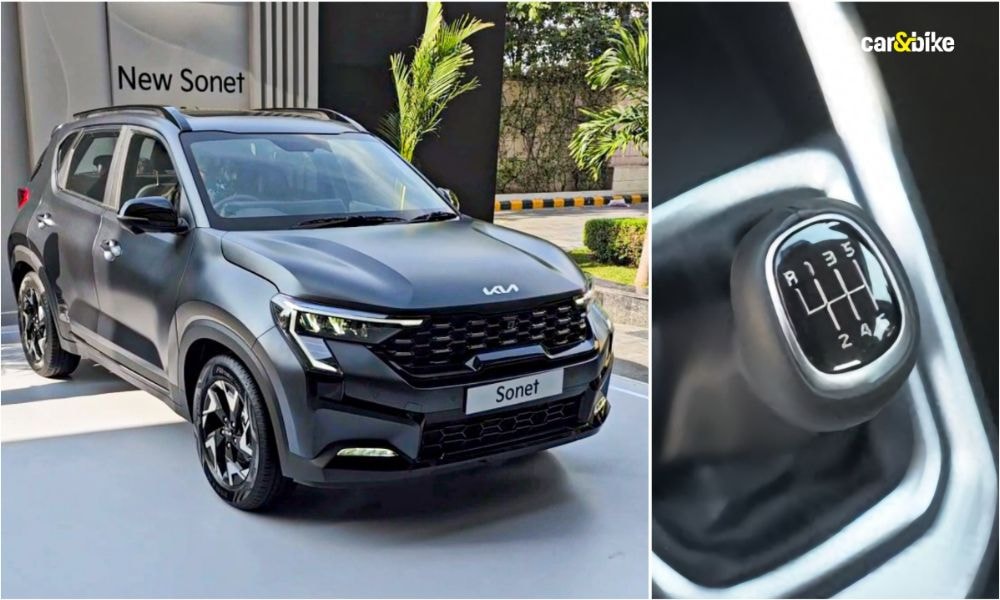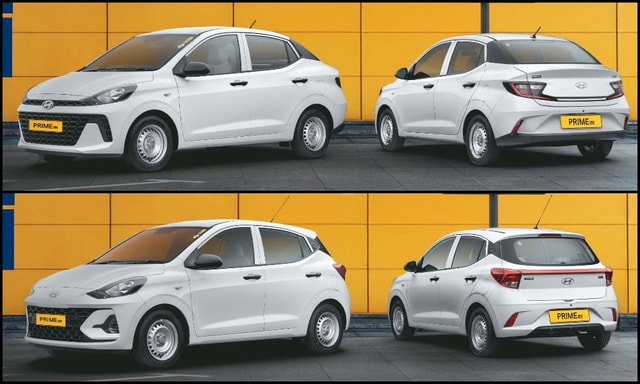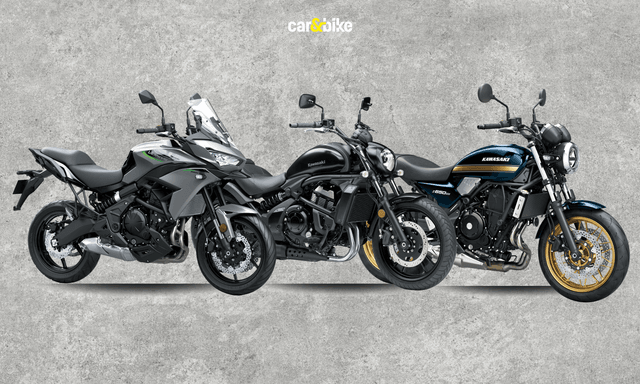Why Kia Reintroduced A Manual With The Facelifted Sonet Diesel

- Buyers of Kia Sonet in upcountry markets prefer a manual over an iMT.
- Kia had replaced the MT option for the Sonet diesel with the iMT, earlier in 2023.
- Facelifted Sonet prices likely to be revealed in January 2024.
After pulling it off the shelves earlier in 2023, Kia India announced the reintroduction of a diesel-manual powertrain option with the Sonet facelift. The subcompact SUV, which has found nearly 3.70 lakh buyers since its launch in 2020, was originally offered with a manual transmission paired with its 1.5-litre diesel engine, but the manual was replaced by the 6-speed intelligent manual transmission (iMT). However, as per a top Kia India official, the move didn't go down too well with prospective Sonet customers in smaller cities and rural markets, which has compelled the carmaker to bring back a traditional manual gearbox with the midlife update.
Also read: Kia Sonet Facelift: Variants Explained
"In the Tier 3, Tier 4 and upcountry markets, we found a lot of entry-level customers who want the manual and they still want to have the feel of pressing the clutch pedal and shifting gears themselves”, Kia India sales head Hardeep Singh Brar told carandbike during a media interaction.
While admitting there was some degree of aversion to the iMT, Brar explained, “I think there are customers who want power on demand. They don’t want the shifting of gears to happen automatically. I think such customers have not really been able to shift [to iMTs].”
Also Read: 2024 Kia Sonet Facelift: All You Need To Know
While an iMT retains a conventional gear shifter, it does away with the clutch pedal, which effectively makes it a semi-automatic car in practice. However, the relative novelty of the tech, along with the higher cost (compared to a regular manual transmission) and potentially high maintenance costs have of late put buyers off the Sonet diesel and made them evaluate other options, especially in rural markets, according to an industry source.
Also Read: Kia Sonet Facelift vs Rivals: Specifications Comparison
In March, Kia ditched the Sonet diesel manual, so the only transmission options for the Sonet diesel were the iMT and the 6-speed automatic. The move to an iMT also pushed the Sonet diesel’s price up by a full Rs 50,000, widening the gap between the entry-level variants of the Sonet petrol and diesel to well over Rs 2 lakh.
With the reintroduction of the manual, Kia is hopeful of once again making the Sonet diesel more accessible to customers, especially the cost-sensitive buyers in upcountry locations. To that end, the diesel-manual combo will only be offered in the entry HTE, HTK, HTK Plus, and mid-spec HTX and HTX Plus.
Also read: Kia To Unveil Electric Vehicle Concepts At CES 2024 Based On PBV
“We are bringing the manual only in the entry and mid variants. In the metros, the iMT becomes a big benefit for users because of the lower price [compared to a conventional automatic] and it gives you the benefit of driving a ‘clutch-less’ car like an automatic. It's not shifting gears, but the clutch that really tires you out. Bringing the manual will help with the price as well, because technology comes at a price”, Brar explained.
The Sonet facelift also brings vital new features such as Level 1 advanced driver assistance systems (ADAS), 360-degree cameras and a 10.25-inch full digital instruments display. Bookings for the Sonet facelift will open on December 20, and prices are expected to be announced early in January 2024.
Latest News
 Jaiveer Mehra | Jan 1, 2026New Kia Seltos India Launch Tomorrow: Here’s What You Should KnowThe second-gen Seltos has grown in size, promising improved interior space while remaining a tech-laden package.1 min read
Jaiveer Mehra | Jan 1, 2026New Kia Seltos India Launch Tomorrow: Here’s What You Should KnowThe second-gen Seltos has grown in size, promising improved interior space while remaining a tech-laden package.1 min read Preetam Bora | Jan 1, 2026Opinion: 2025 – The Year Of the Mid-Size Motorcycle Boom In IndiaThe mid-size motorcycle segment, encompassing 250-500 cc, truly came into its own in 2025. But will it be sustained going forward with increased GST rates?1 min read
Preetam Bora | Jan 1, 2026Opinion: 2025 – The Year Of the Mid-Size Motorcycle Boom In IndiaThe mid-size motorcycle segment, encompassing 250-500 cc, truly came into its own in 2025. But will it be sustained going forward with increased GST rates?1 min read Jaiveer Mehra | Dec 31, 2025Hyundai Creta Sales Cross 2 Lakh Units In CY2025Carmaker said the Creta diesel still accounts for over 40 per cent of all units sold, while the share of first time buyers stands at over 30 per cent.1 min read
Jaiveer Mehra | Dec 31, 2025Hyundai Creta Sales Cross 2 Lakh Units In CY2025Carmaker said the Creta diesel still accounts for over 40 per cent of all units sold, while the share of first time buyers stands at over 30 per cent.1 min read Carandbike Team | Dec 30, 2025Hyundai Aura, Nios-Based Prime SD & Prime HB Taxis Launched In IndiaCarmaker rebrands fleet models under the Hyundai Prime brand rather than as separate variants of its passenger car range, as it previously did with the Xcent1 min read
Carandbike Team | Dec 30, 2025Hyundai Aura, Nios-Based Prime SD & Prime HB Taxis Launched In IndiaCarmaker rebrands fleet models under the Hyundai Prime brand rather than as separate variants of its passenger car range, as it previously did with the Xcent1 min read car&bike Team | Dec 30, 2025VinFast's V-Green Partners With Hindustan Petroleum To Setup EV Charging StationsV-Green is owned by Pham Nhat Vuong, Chairman of Vingroup Corporation and founder of VinFast.1 min read
car&bike Team | Dec 30, 2025VinFast's V-Green Partners With Hindustan Petroleum To Setup EV Charging StationsV-Green is owned by Pham Nhat Vuong, Chairman of Vingroup Corporation and founder of VinFast.1 min read Jafar Rizvi | Dec 30, 20252026 Kawasaki Versys 650, Vulcan S, Z650RS Launched: Now E20 CompatibleKawasaki has updated its 650cc range of motorcycles with E20 fuel compatibility and is offering new paint schemes.1 min read
Jafar Rizvi | Dec 30, 20252026 Kawasaki Versys 650, Vulcan S, Z650RS Launched: Now E20 CompatibleKawasaki has updated its 650cc range of motorcycles with E20 fuel compatibility and is offering new paint schemes.1 min read
 Preetam Bora | Dec 30, 2025TVS Orbiter Review: Real-World Performance and Range TestedThe TVS Orbiter is a promising electric scooter promising decent range, practicality and pricing. But is there any reason to avoid it? We spent a few days getting to know it better.9 mins read
Preetam Bora | Dec 30, 2025TVS Orbiter Review: Real-World Performance and Range TestedThe TVS Orbiter is a promising electric scooter promising decent range, practicality and pricing. But is there any reason to avoid it? We spent a few days getting to know it better.9 mins read Jafar Rizvi | Dec 24, 2025MG Windsor EV 38 kWh Long-Term Report: IntroductionThe Windsor EV has joined our garage, and before it settles into daily duty, I took it out to get a sense of what living with an electric car is like.4 mins read
Jafar Rizvi | Dec 24, 2025MG Windsor EV 38 kWh Long-Term Report: IntroductionThe Windsor EV has joined our garage, and before it settles into daily duty, I took it out to get a sense of what living with an electric car is like.4 mins read Seshan Vijayraghvan | Dec 23, 20252026 Kia Seltos Review: Formula Is Spot On, But Is The Timing Right?The 2nd-gen Kia Seltos has arrived, but it has the challenge of facing strong rivals like the Victoris and Sierra. The question is simple - Does it still have what it takes?9 mins read
Seshan Vijayraghvan | Dec 23, 20252026 Kia Seltos Review: Formula Is Spot On, But Is The Timing Right?The 2nd-gen Kia Seltos has arrived, but it has the challenge of facing strong rivals like the Victoris and Sierra. The question is simple - Does it still have what it takes?9 mins read car&bike Team | Dec 26, 2025Tata Punch EV Long-Term Second Report: Highway Performance, Pros & ConsAfter a week of living with the Tata Punch EV Long Range—including a proper Mumbai-Nashik highway test—we've learned what this little electric SUV is really made of.1 min read
car&bike Team | Dec 26, 2025Tata Punch EV Long-Term Second Report: Highway Performance, Pros & ConsAfter a week of living with the Tata Punch EV Long Range—including a proper Mumbai-Nashik highway test—we've learned what this little electric SUV is really made of.1 min read Seshan Vijayraghvan | Dec 22, 20252026 Tata Harrier & Safari 1.5 Hyperion Review: By The Power Of Petrol!The new Tata Harrier and Safari petrol packs a new 1.5-litre TGDI Hyperion engine, but is it an ideal alternative to the diesel version?7 mins read
Seshan Vijayraghvan | Dec 22, 20252026 Tata Harrier & Safari 1.5 Hyperion Review: By The Power Of Petrol!The new Tata Harrier and Safari petrol packs a new 1.5-litre TGDI Hyperion engine, but is it an ideal alternative to the diesel version?7 mins read

































































































































